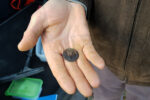 University of Leiden researchers have found evidence that a group of Romans coins found near the River Aa in Brabant, the Netherlands, were deposited as offerings by travelers seeking safe passage across the river. The hoard was discovered by metal detectorist brothers Wim and Nico Schaijk in a field in the village of Berlicum in November of 2017. They found 107 coins — 103 bronze sesterces and axes, four silver denarii — in freshly turned soil on the bank of the River Aa in Berlicum. Most of them date to the 1st and 2nd century.
University of Leiden researchers have found evidence that a group of Romans coins found near the River Aa in Brabant, the Netherlands, were deposited as offerings by travelers seeking safe passage across the river. The hoard was discovered by metal detectorist brothers Wim and Nico Schaijk in a field in the village of Berlicum in November of 2017. They found 107 coins — 103 bronze sesterces and axes, four silver denarii — in freshly turned soil on the bank of the River Aa in Berlicum. Most of them date to the 1st and 2nd century.
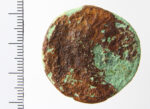
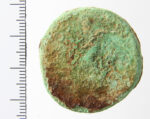 They reported their discoveries and in 2018, the find site was surveyed by archaeologists. A single test trench revealed that the coins originated in a soil layer thick with natural iron concretions. Most of the coins are encrusted with a thick crust of iron consistent with the ferrous layer in the soil, indicating they were in that spot together for a long time. The excavation also unearthed two more Roman copper alloy coins, a the head of a hair bobbin and a broken metal curved piece that may have been finger ring.
They reported their discoveries and in 2018, the find site was surveyed by archaeologists. A single test trench revealed that the coins originated in a soil layer thick with natural iron concretions. Most of the coins are encrusted with a thick crust of iron consistent with the ferrous layer in the soil, indicating they were in that spot together for a long time. The excavation also unearthed two more Roman copper alloy coins, a the head of a hair bobbin and a broken metal curved piece that may have been finger ring.
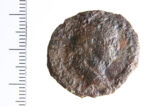
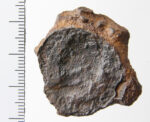 The oldest identifiable coin is a silver denarius from the Roman Republic minted by Calpurnius in 90 B.C. The other three denarii were minted under Vespasian and Trajan. There are many unidentifiable coins because the 105 coppers are extremely corroded. The most recent that can be dated was minted under Marcus Aurelius (161-180 A.D.), but that doesn’t put an endpoint on the deposition date because 2nd century Roman copper coins were in circulation in North Brabant well into the 3rd century as the supply of new coins dwindled to nothing..
The oldest identifiable coin is a silver denarius from the Roman Republic minted by Calpurnius in 90 B.C. The other three denarii were minted under Vespasian and Trajan. There are many unidentifiable coins because the 105 coppers are extremely corroded. The most recent that can be dated was minted under Marcus Aurelius (161-180 A.D.), but that doesn’t put an endpoint on the deposition date because 2nd century Roman copper coins were in circulation in North Brabant well into the 3rd century as the supply of new coins dwindled to nothing..
The date range and distribution of the coins suggest they were deposited slowly and regularly for more than a century, an accumulated deposition rather than a hoard buried in a single event. Coins and jewelry were deposited on the banks of a river in an area that flooded regularly and was consistently soggy. Votive deposits were often left in or next to bodies of water as rivers, lakes, waterfalls and wetlands had ritual significance.
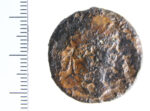
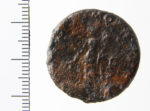 Chemical analysis found that the ferric hydroxide crust began to form on the coins very soon after they were deposited. There is no evidence of erosion or flushing as the coins were found on the marshy shore and would obviously have shifted down the bank to the bottom of the river if subject to erosion or flushing. Any washout that occurred had minimal impact on the positioning of the coins, at most shifting them only slightly vertically and/or horizontally.
Chemical analysis found that the ferric hydroxide crust began to form on the coins very soon after they were deposited. There is no evidence of erosion or flushing as the coins were found on the marshy shore and would obviously have shifted down the bank to the bottom of the river if subject to erosion or flushing. Any washout that occurred had minimal impact on the positioning of the coins, at most shifting them only slightly vertically and/or horizontally.
The coins were found on the shore of a narrow, shallow part of the river. There is no evidence of a dam or bridge or any other construction there, but it was likely a ford in the river. Archaeologists hypothesize that the coins were tossed into the water at the shore to ensure safe passage by people about to ford the stream.
The coins are evidence that Roman activity in what is now the Netherlands wasn’t just concentrated along the fortifications on the Rhine and the Waal rivers. Even in the interior, spots like the ford were well-frequented transit areas between important Roman centers like the monumental temple complex of Hercules Magusanus at Empel, just five miles north of Berlicum, or Nijmegen, the oldest city in the Netherlands, less than 30 miles to the northwest.
Leiden University researcher Liesbeth Claes:
“In the 1832 entry in the land registry – one of the Netherlands’ oldest detailed maps – my colleagues noticed that at that time there was a path cutting across the river. Apparently there was a ford on this spot, where people could wade through the river. Later, the ford fell into disuse. This information, together with the find of the coins, convinced us that travellers in Roman times brought offerings here for a safe crossing. It may not have been a particularly rapidly flowing river, but for traders in particular it was important to be able to transport their goods safely to the other side. And there’s also the fact that in ancient times rivers always had some sacred connections.”
“Quamvis sint sub aqua, trans aquam itinere temptant.” 😀
Their drainage systems from two thousand years ago were probably not quite the ones that they currently have in place.
Apparently, the way around the Low Countries was more viable than the passage right through.
Any shortcuts were probably rather adventurous and not very safe.
omnesviae.org/#!iter_TPPlace553_TPPlace590
omnesviae.org/en/viewer/